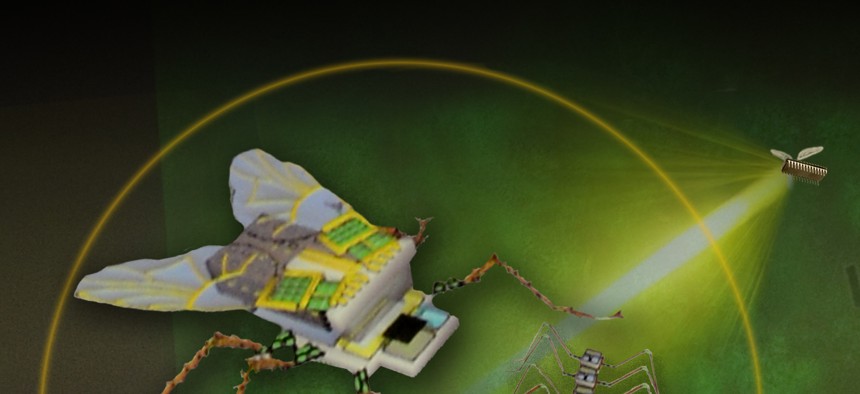
This illustration depicts a simulated briefing about the micro-robotic fly and millipede that Dr. Ron Polcawich and his PiezoMEMS team are developing at the Army Research Laboratory, in Adelphi, Md PEGGY FRIESON / ARMY
The Military Wants Smarter Insect Spy Drones
Tiny flying machines need better brains before they can start spying on you. By Patrick Tucker
The Defense Advanced Projects Research Agency put out a broad agency announcement this week seeking software solutions to help small drones fly better in tight enclosed environments. The Fast Lightweight Autonomy program, the agency said, “focuses on creating a new class of algorithms to enable small, unmanned aerial vehicles to quickly navigate a labyrinth of rooms, stairways and corridors or other obstacle-filled environments without a remote pilot.”
The solicitation doesn’t focus on new drone designs so much as helping very small drones -- able to fit through an open window and fly at 45 miles per hour -- navigate tight and chaotic indoor spaces without having to communicate with operators, get GPS directions, or receive data from external sensors. All the thinking, steering and landing would be in the drone.
“Goshawks, for example, can fly very fast through a dense forest without smacking into a tree. Many insects, too, can dart and hover with incredible speed and precision. The goal of the FLA program is to explore non-traditional perception and autonomy methods that would give small UAVs the capacity to perform in a similar way, including an ability to easily navigate tight spaces at high speed and quickly recognize if it had already been in a room before,” Mark Micire, DARPA program manager, said in a press release.
The agency put out this video to demonstrate what they’re looking for.
Urban disaster relief is an “obvious” application for tiny, self-guided insect robots according to the agency. An equally obvious application, left out of the announcement, is spy drones that can fly independently into rooms, find a perch, and serve as a fly on the wall in a very real (but robotic) sense of the world.
As new materials come online, researchers are quickly getter better at miniaturizing flying machines. Supposedly, the world's smallest drone is this robofly from Harvard (DARPA funded) at 60 milligrams and 3 centimeters.
The military is working on a version that’s three times smaller. On Dec. 16, the Army Research Laboratory announced that they had created a tiny fly drone of comparable size to the robofly with wings made of lead zirconium titanate.
But creating a miniature flying machine isn’t as simple as creating something that can take off and land while attached to a wire. There’s more that goes into flight than pure mechanics. It takes brains. Ron Polcawich, head of the Army Research Lab's piezoelectric microelectromechanical systems, or PiezoMEMS team, says it may take another 15 years of research before fly drones can move through the air, land and behave like real bugs.
In this paper titled Towards Autonomous Navigation of Miniature UAV , a group of researchers from NASA, IEEE and other outfits describe the high level of difficulty in getting a machine that’s the size of an insect to actually think like one, much less think like a bird.
“A major algorithmic challenge is to process sensor information at a high rate to provide vehicle control and higher level tasks with real-time position information and vehicle states.”
Why is it such a challenge to make a tiny drone locate itself in space and decide on a destination? Because a flying machine that size doesn’t have much room to carry a computer capable of crunching all the visual data (from a camera) that it needs for flight, especially if it’s also going to carry a battery as well. “Since micro rotorcrafts can only carry a few grams of payload including batteries, this has to be accomplished with a very small weight and power budget… Additionally, novel algorithmic implementations with minimal computational complexity, such as presented in this paper, are required,” they write.
The paper demonstrates an autonomous algorithmic flying solution for a quadcopter of a much more bird-sized 12 grams. No, it doesn’t solve the problem of teaching a computer the size of a golf ball to see, dodge obstacles in the air and land on a dime, but it does provide an idea of where research is headed.
“The implementation on an ultra-light weight platform of only 12g is a huge step towards ultimately having a fully capable avionics package (flight computer, camera, and IMU) under 15g. It will enable fully autonomous control of ultrasmall quadrotor systems (as e.g. the 15cm, 25g Bitcraze miniature quadrotor system) that can be deployed for indoor and outdoor [intelligence search and reconaissance] missions in confined spaces while maintaining stealth.”
If progress in machine vision algorithms continues at its current rate that 15-year forecast until the flight of the flying robot insects may be conservative.


